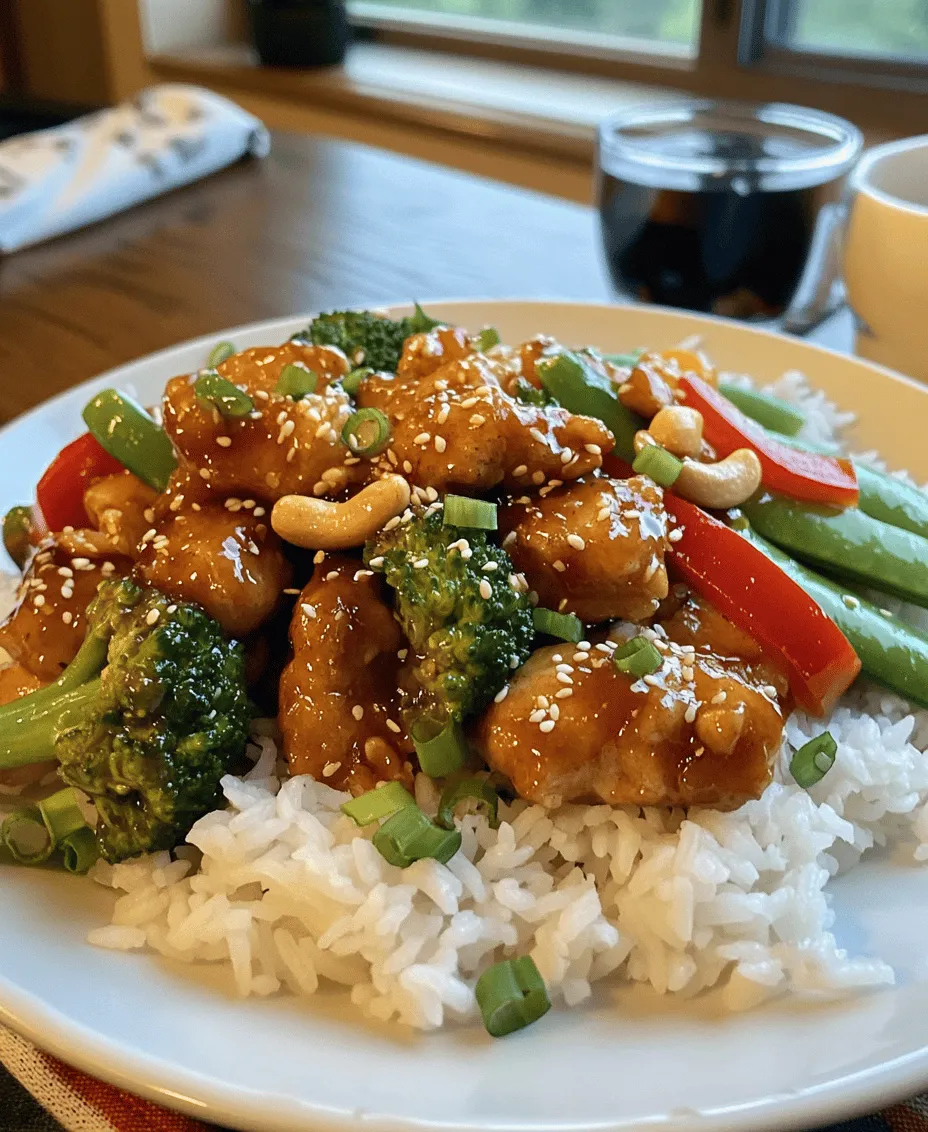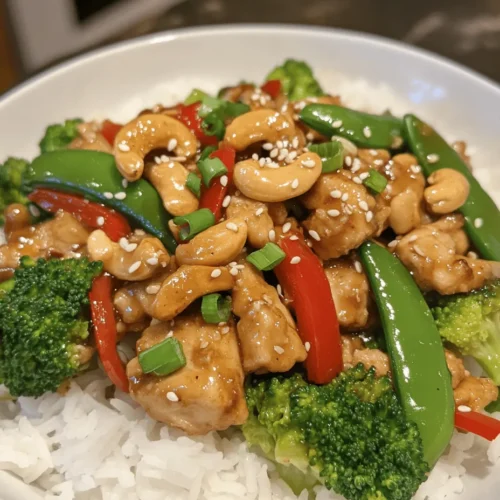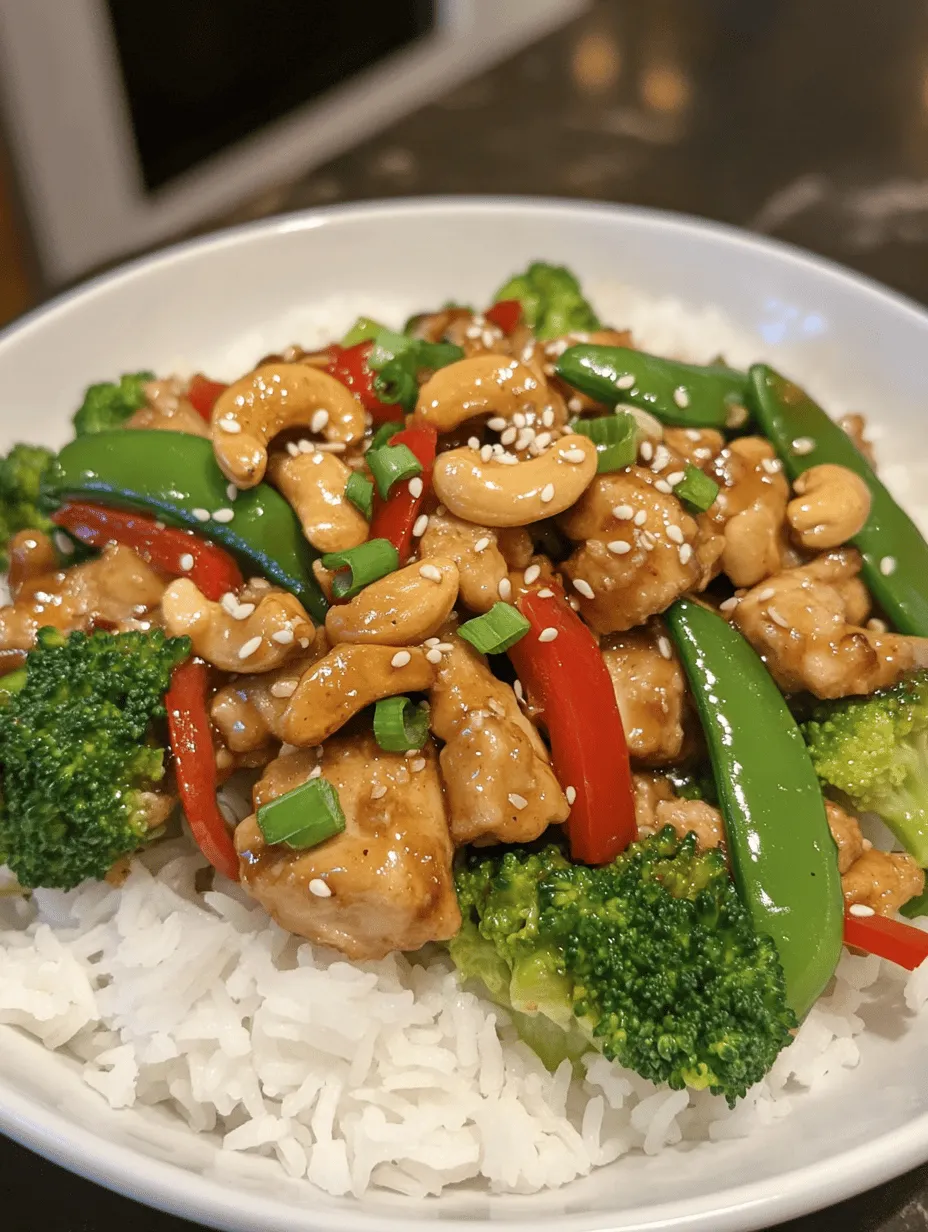Unleash the flavors of Asian cuisine right in your kitchen with this Better-Than-Takeout Cashew Chicken recipe. This dish is not just a healthier alternative to your favorite takeout; it’s also packed with vibrant vegetables, tender chicken, and crunchy cashews, all enveloped in a delightful sauce. If you’ve ever craved that satisfying combination of savory and sweet flavors that you find in restaurant dishes, this recipe will help you recreate that experience at home.
In this article, we will explore the essential ingredients that make this dish shine, provide detailed step-by-step instructions, discuss the nutritional benefits of each component, and offer ways to customize the recipe to your taste preferences. Whether you’re cooking for yourself, your family, or impressing guests, the Better-Than-Takeout Cashew Chicken is sure to become a favorite in your culinary repertoire.
Understanding the Ingredients
Exploring the Key Ingredients
The success of any recipe lies in the quality and combination of its ingredients. For our Better-Than-Takeout Cashew Chicken, we will focus on a few key components that not only contribute to the dish’s flavor but also offer various health benefits.
Boneless, Skinless Chicken Breasts
At the heart of this dish is boneless, skinless chicken breasts. This lean protein source is versatile, easy to cook, and absorbs flavors beautifully. Chicken is an excellent choice for those looking to maintain a healthy diet, as it is low in fat and high in protein. The marination process enhances the chicken’s flavor and tenderness, making it the perfect base for our dish.
Raw Cashews
Cashews provide a delightful crunch and a subtle creaminess that elevates the dish’s texture. They are not only delicious but also packed with nutrients, including healthy fats, protein, and essential minerals like magnesium and zinc. These nuts can help promote heart health and contribute to overall well-being. For the best flavor and texture, it’s important to use raw cashews and toast them just before serving.
Fresh Vegetables: Broccoli, Red Bell Pepper, Snap Peas
A colorful array of fresh vegetables is essential for a well-rounded dish. In this recipe, we will use broccoli, red bell peppers, and snap peas. Broccoli is a nutritional powerhouse, rich in vitamins K and C, fiber, and antioxidants. Red bell peppers add sweetness and are high in vitamin A, while snap peas provide a satisfying crunch and are a good source of vitamins C and K. The combination of these vegetables not only enhances the visual appeal of the dish but also increases its nutritional profile.
Aromatic Flavors: Garlic and Ginger
Garlic and ginger are staples in Asian cuisine, known for their aromatic qualities and health benefits. Garlic has been linked to various health benefits, including improved immune function, while ginger is renowned for its anti-inflammatory and digestive properties. Together, they create a flavorful base that complements the other ingredients beautifully.
Sauces: Low-Sodium Soy Sauce, Hoisin Sauce, Sesame Oil
The sauce is where the magic happens! In our recipe, we will use low-sodium soy sauce, hoisin sauce, and sesame oil. Low-sodium soy sauce delivers that umami flavor without the excess salt, making it a healthier choice. Hoisin sauce adds a touch of sweetness and depth, while sesame oil contributes a rich, nutty aroma. This combination creates a balanced sauce that enhances the overall flavor of the dish.
Cornstarch and Water: For Marination and Sauce Thickening
Finally, we will use cornstarch mixed with water for marinating the chicken and thickening the sauce. Cornstarch helps to lock in moisture during cooking, resulting in tender chicken. It also thickens the sauce to the perfect consistency, ensuring that it clings to the chicken and vegetables without being too runny.
Nutritional Benefits of Each Ingredient
Understanding the nutritional benefits of our key ingredients is vital for appreciating this dish fully.
Health Benefits of Chicken
Chicken is an excellent source of protein, which is essential for muscle growth, repair, and overall body function. It contains important nutrients such as B vitamins, which help with energy metabolism, and selenium, which plays a crucial role in antioxidant defense. By choosing boneless, skinless chicken breasts, you minimize fat intake while maximizing protein consumption.
Nutritional Profile of Cashews
Cashews are nutrient-dense, offering healthy fats, protein, fiber, and a range of essential vitamins and minerals. One ounce of cashews contains about 5 grams of protein, along with heart-healthy monounsaturated fats that can help lower bad cholesterol levels. Additionally, cashews are rich in copper, vital for energy production and iron metabolism.
The Role of Vegetables in a Balanced Diet
Incorporating a variety of vegetables into your meals is crucial for maintaining a balanced diet. The vegetables in this recipe provide fiber, vitamins, and antioxidants that support overall health. Fiber aids digestion and helps maintain a healthy weight, while vitamins from broccoli, bell peppers, and snap peas contribute to immune function and skin health.
Impact of Soy and Hoisin Sauce on Flavor and Health
Both soy sauce and hoisin sauce are flavorful additions that enhance the dish’s profile. While they do contain sodium, using low-sodium soy sauce minimizes the risk of excessive salt intake. Hoisin sauce, often used as a dipping sauce or marinade, is typically made from fermented soybeans, sugar, and various spices, combining sweetness with umami. When used in moderation, these sauces can enrich the dish without compromising health.
Preparation Steps for Better-Than-Takeout Cashew Chicken
Now that we have a solid understanding of the key ingredients and their nutritional benefits, let’s dive into the preparation steps for our Better-Than-Takeout Cashew Chicken.
Marinating the Chicken
The first step in achieving flavorful cashew chicken is marinating the chicken. Marination is essential as it allows the flavors to penetrate the meat, resulting in a juicy and tender dish.
Importance of Marination for Flavor
Marinating the chicken not only enhances its taste but also helps to break down proteins, making the meat more tender. The combination of soy sauce, cornstarch, and other ingredients in the marinade will infuse the chicken with rich flavors. This step is crucial for achieving that authentic restaurant-quality taste right in your home kitchen.
How Long to Marinate for Optimal Taste
For optimal flavor, it’s best to marinate the chicken for at least 30 minutes. If you have the time, marinating for 1 to 2 hours will yield even better results. Simply combine cubed chicken breasts with the marinade ingredients in a bowl or resealable bag, ensuring that each piece is well-coated. Place it in the refrigerator during this time to allow the flavors to meld.
Creating the Sauce
While the chicken is marinating, you can prepare the sauce, which is the heart of our cashew chicken recipe.
Simple Steps to Prepare the Sauce
To create the sauce, gather your low-sodium soy sauce, hoisin sauce, and sesame oil. In a bowl, whisk together equal parts of soy sauce and hoisin sauce, along with a dash of sesame oil. You can adjust the ratios according to your taste preference, adding more hoisin for sweetness or more soy sauce for saltiness.
Explanation of Each Sauce’s Role
– Soy Sauce: Adds the savory umami flavor that is a hallmark of Asian dishes.
– Hoisin Sauce: Brings sweetness and depth, balancing the savory notes of soy sauce.
– Sesame Oil: Provides a fragrant, nutty aroma that enhances the overall flavor profile.
Once combined, set the sauce aside until you’re ready to stir-fry the chicken and vegetables.
Toasting the Cashews
Toasting the cashews is a simple yet essential step that elevates their flavor and texture.
Techniques for Perfectly Toasted Cashews
To toast cashews, preheat a dry skillet over medium heat. Add the raw cashews in a single layer and stir frequently to prevent burning. Toast them for about 5-7 minutes until they become golden brown and release a fragrant aroma. Keep a close eye on them, as they can go from perfectly toasted to burnt quickly.
Enhancing Flavor through Toasting
Toasting not only enhances the flavor of cashews but also adds a delightful crunch to the dish. Once toasted, set them aside to cool before adding them to the final dish, ensuring they retain their crunchiness.
Stir-Frying the Vegetables
The final step in preparing our Better-Than-Takeout Cashew Chicken involves stir-frying the vegetables.
The Best Method for Stir-Frying
To achieve that perfect stir-fry texture, it’s important to use high heat and a non-stick skillet or wok. Start by heating a tablespoon of oil in the pan until it shimmers. Add the minced garlic and ginger, stirring for about 30 seconds until fragrant. Then, add the broccoli, red bell peppers, and snap peas, stirring continuously for 3-4 minutes until the vegetables are tender but still crisp.
Stir-frying at high heat helps to lock in the nutrients and maintain the vibrant colors of the vegetables, creating a visually appealing dish.
As we proceed, we will combine all these elements into a cohesive and flavorful meal that will impress anyone who tries it. The following sections will cover the complete cooking process, plating, serving suggestions, and tips for making this dish your own. Stay tuned for more delicious details on transforming your kitchen into an Asian culinary haven!

Tips for Retaining Vegetable Crunch
One of the key aspects of a great cashew chicken dish is the texture of the vegetables. You want them to be crisp and vibrant, not soggy or overcooked. Here are some crucial tips to achieve that perfect crunch:
1. Prep Your Vegetables Ahead of Time: Cut your vegetables into uniform pieces to ensure even cooking. This not only helps them cook at the same rate but also enhances the visual appeal of the dish.
2. Use High Heat: When stir-frying, make sure your pan or wok is hot enough before adding the vegetables. High heat helps to sear the vegetables quickly, locking in moisture while maintaining their crunch.
3. Timing is Key: Add your vegetables in stages, starting with those that take longer to cook, such as carrots and bell peppers, and adding more delicate vegetables like snap peas or broccoli last. This ensures that every vegetable is cooked perfectly.
4. Blanching for Extra Crunch: For vegetables like broccoli or green beans, consider blanching them first in boiling water for 1-2 minutes and then shocking them in ice water. This technique preserves their color and crunch.
Cooking the Chicken
Achieving the Perfect Cook: Tips and Tricks
Cooking the chicken to perfection is crucial for a successful cashew chicken dish. Here are some strategies to consider:
– Marinate Your Chicken: A simple marinade of soy sauce, garlic, and a touch of cornstarch can enhance the flavor and tenderness of the chicken. Allow it to marinate for at least 30 minutes, or longer if possible.
– Cut Against the Grain: When slicing your chicken, make sure to cut against the grain. This will make the pieces more tender when cooked.
– Cook in Batches: Avoid overcrowding the pan, as this can lead to steaming rather than searing. Cook the chicken in batches to ensure it caramelizes nicely, developing that beloved stir-fry flavor.
Importance of Even Cooking
Even cooking is essential for both texture and flavor. Here’s how to ensure your chicken cooks evenly:
– Use a Thermometer: The best way to ensure your chicken is cooked through without being dry is to use a meat thermometer. Chicken should reach an internal temperature of 165°F (75°C).
– Let It Rest: After cooking, allow the chicken to rest for a few minutes. This helps the juices redistribute, resulting in juicier pieces.
Combining Ingredients for the Final Dish
Timing and Order of Adding Ingredients
The order in which you add your ingredients to the pan can significantly affect the final flavor and texture of your dish:
1. Start with Aromatics: Begin by sautéing garlic and ginger in oil to release their flavors. This creates a fragrant base for your dish.
2. Add Chicken Next: Once the aromatics are fragrant, add the marinated chicken. Cook until golden brown and fully cooked through.
3. Incorporate Vegetables: Add the vegetables according to their cooking times, starting with the harder vegetables first and finishing with the softer ones.
4. Finish with Sauce: Once the chicken and vegetables are cooked, pour in your sauce mixture, stirring to coat everything evenly. This allows the sauce to thicken slightly and adhere to the chicken and vegetables.
Ensuring a Balanced Flavor Profile
To achieve a well-rounded flavor, consider the following:
– Taste as You Go: Always taste your dish before serving. Adjust the seasoning with salt, pepper, or additional soy sauce if necessary.
– Balance Sweet and Savory: Cashew chicken typically has a sweet and savory profile. If your sauce is too sweet, add a splash of vinegar or lime juice for acidity to balance it out.
Serving Suggestions
Best Accompaniments for Cashew Chicken
Pairing your cashew chicken with the right sides can elevate the meal:
– Ideal Grains: Rice or Quinoa: Serve your cashew chicken over steamed jasmine rice for a classic pairing. If you’re looking for a healthier alternative, quinoa is a great option, offering a nutty flavor and extra protein.
– Suggested Side Dishes: Salads or Steamed Vegetables: A light side salad with a tangy vinaigrette can cut through the richness of the dish, while steamed vegetables can enhance the overall healthiness of your meal.
Garnishing Techniques
Presentation plays a key role in making your dish appealing. Consider these garnishing techniques:
– How to Use Green Onions and Sesame Seeds for Presentation: Chopped green onions add a fresh burst of color and flavor. Toasted sesame seeds not only add crunch but also a nutty aroma. Sprinkle both generously over your finished dish for an eye-catching presentation.
– Creating Visual Appeal on the Plate: When plating, consider the color contrast. Use a white plate to make the vibrant colors of your cashew chicken pop. Arrange the chicken and vegetables artfully, allowing the grains to peek through.
Exploring Variations
Customizing Your Cashew Chicken
One of the best aspects of cooking is the ability to customize. Here are some variations for your cashew chicken:
– Substituting Proteins: Tofu or Shrimp: For a vegetarian option, replace chicken with firm tofu, marinating and cooking it in the same way. Shrimp is another excellent alternative that cooks quickly and adds a touch of elegance to your dish.
– Adding Different Vegetables: Carrots, Bell Peppers, or Zucchini: Feel free to include or substitute vegetables based on what you have on hand. Carrots add sweetness, bell peppers bring a slight crunch, and zucchini offers a mild flavor and texture.
– Adjusting Spice Levels: Adding Heat with Chili Flakes: If you enjoy a bit of heat, sprinkle some red chili flakes into the sauce or sauté fresh sliced chili peppers with the garlic and ginger.
Storage and Reheating Tips
Proper Storage Methods
To ensure your cashew chicken remains fresh and delicious, follow these storage tips:
– How to Store Leftovers Safely: Allow your dish to cool completely before transferring it to an airtight container. Store in the refrigerator for up to 3 days. If you need to store it longer, consider freezing it in portion-sized containers for up to 3 months.
– Best Practices for Maintaining Freshness: To maintain the crunch of the vegetables, consider storing the sauce separately if possible. Combine just before reheating.
Reheating Techniques
To enjoy your leftovers without compromising on flavor or texture, consider these reheating methods:
– Recommended Methods for Reheating Without Losing Flavor: The best way to reheat cashew chicken is in a skillet over medium heat. Add a splash of water or broth to prevent sticking and to steam the vegetables slightly, reviving their crunch. Stir often until heated through.
Conclusion
Bringing the taste of takeout into your home kitchen has never been easier with this Better-Than-Takeout Cashew Chicken recipe. With its balanced ingredients, quick preparation, and delicious outcome, it’s sure to become a staple in your weekday dinner rotation. By understanding the nutritional benefits, mastering the preparation steps, and exploring variations, you can create a dish that not only satisfies your palate but also supports your health and wellness goals. Enjoy the experience of cooking and the satisfaction of a delicious homemade meal.



